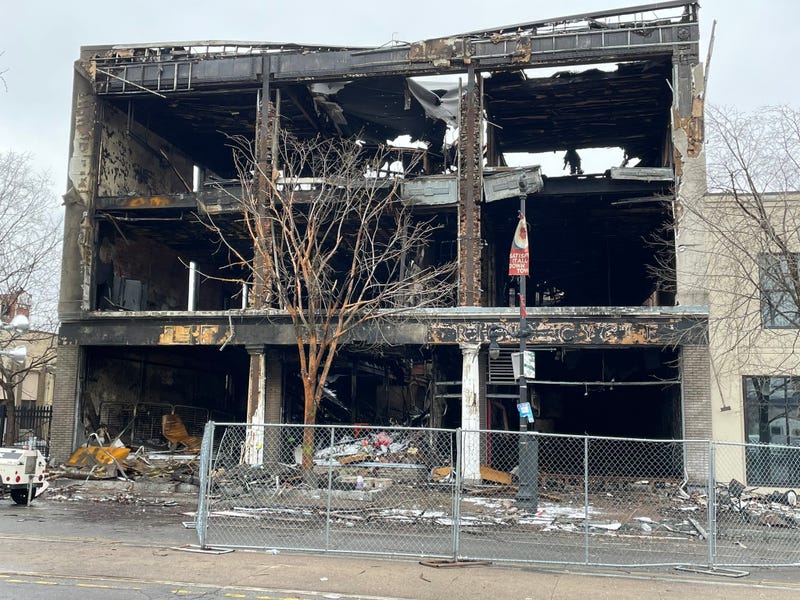
Buffalo, N.Y. (WBEN) - The on-site investigation into the fatal fire at 745 Main Street in Downtown Buffalo that killed Buffalo Firefighter Jason Arno is officially complete.
A spokesperson from the City of Buffalo officially announced the conclusion into the on-site investigation on Monday, as the focus now shifts towards the Erie County District Attorney Office's part of the investigation. It'll be up to the DA's Office to determine whether or not any sort of criminal charges can be pursued as a result of the blaze.
Investigators worked for nearly two weeks to determine what ended up causing the deadly fire in the city's Theatre District. The investigation was led by Buffalo Fire Investigators and the Bureau of Alcohol, Tobacco, Firearms and Explosives (ATF), with the help of a number of other agencies.
One of the local agencies who helped with the investigation was the Erie County Sheriff's Office and their own fire investigation unit. Scott Kuhlmey is one of the fire investigators with the Erie County Sheriff's Office, and says the work that went into this investigation was extensive.
"With any fire investigation, we start with a standardized process where we collect data - 9-1-1, calls witnesses, occupants, tenants, property owners - and begin to understand the facts around the fire. Then once we have that information we look at the fire building itself, and we look at fire damage and fire patterns that help us narrow down an area of a building where the fire may have started," said Kuhlmey on Tuesday during an appearance on WBEN.
During the investigation, Buffalo Fire and ATF officials said they spoke with more than 100 people when looking into what started the fire, what they noticed during the fire, and much more. Kuhlmey says while the interviews and the other factors of what happened that Wednesday can start to pile up, it's all part of the process in order to piece the puzzle together.
"The people that we speak to, the people that we interview, the phone calls we receive all contribute to understanding how the fire started and the circumstances around it," he said. "The information we received from people and then the building itself, the building tells a story. So looking at the outside and working ourselves into the building, by what we see in way of damage can certainly help us understand where a fire may have started."
When looking into the building, Kuhlmey explains there's a lot of variables the consider when determining potential causes.
"Depending on the size of the building, the configuration of it and the contents of the building. All those things are factors that play into the intensity of a fire, and how a fire spreads," he said.
Despite the fire that broke out at 745 Main Street taking a toll on the structure and burning a large portion of the building, Kuhlmey says there are a lot of clues that allow for investigators to begin their evaluations, starting from the outside and working in.
"There are a lot of things that we look for," Kuhlmey said. "We look at fire effects, which are melting and charring and oxidation, all kinds of different patterns that help support or help direct us as to where the fire of may have started. We examine the fire debris and the way the fire debris looks, and the amount of damage to it helps us understand a little bit better, and helps narrow it down for us."
In many instances with a large fire such as this, while there is plenty of destruction and devastation, investigators are often able to figure out ways to pinpoint a specific location of the structure where the blaze likely started, and then use other variables at-hand to determine the exact cause.
"When you begin speaking with occupants, when you start looking at the fire damage and we narrow it down to the area of a building where the fire starts, what we then look for is the ignition source. What actually brought the heat, fuel and oxygen together to create the fire?," Kuhlmey explained. "When you get into an isolated area - an area of origin, we call it - when we get to there, then we're able to start eliminating different potential causes."
While Kuhlmey can't say what the exact cause of the fire was in the case with 745 Main Street, he says it's important with any fire that investigators need to have a level of certainty and avoid any levels of bias.
"We don't want to take information that we receive initially, and run with that. We want to make sure we're objective, we want to make sure we look at all potential causes," Kuhlmey said. "Initially, when you're receiving information, sometimes it goes in one direction. However, as the investigation unfolds, it can sometimes go into several different directions."
More from Kuhlmey's interview during "A New Morning" with Brian Mazurowski and Susan Rose is available in the player below:

